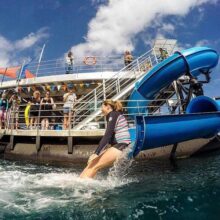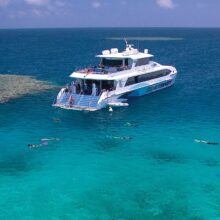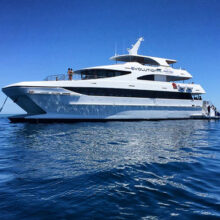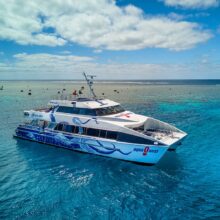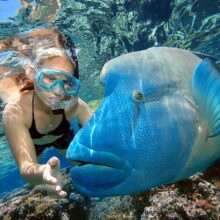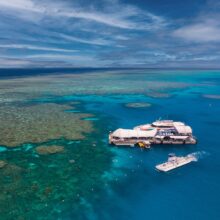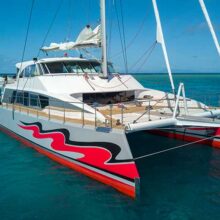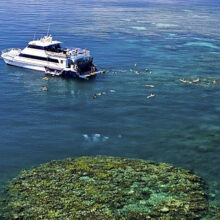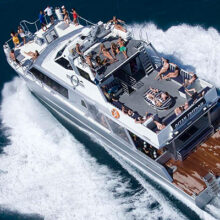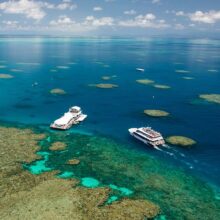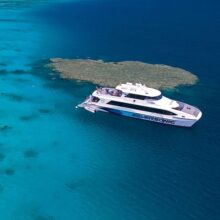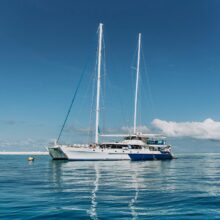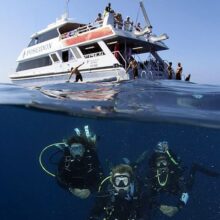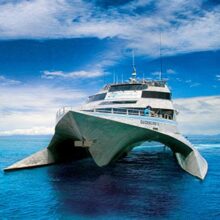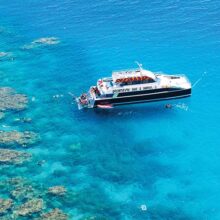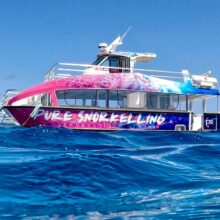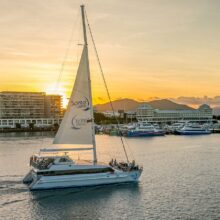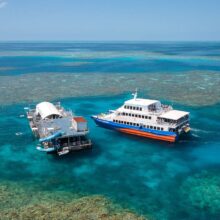The ultimate guide to the Great Barrier Reef
The largest coral reef system in the world is the Great Barrier Reef, a natural wonder off the Australian coast. It supports a remarkable diversity of marine life and makes a significant contribution to the Australian economy through fishing and tourism. The Great Barrier Reef will be examined in this guide along with its history, geology, marine life, and information on how to travel to and enjoy this incredible snorkeling and diving location.
VIEW SELECTED TOURS BELOW:
Sunlover Cruises
Silverswift Dive & Snorkel
Evolution Dive & Snorkel Cruise
Divers Den: Aqua Quest
Do you need help choosing?
Can't decide? We have personally been on every Cairns reef and diving trip. We can help you choose the best tour, to suit your experience and budget.
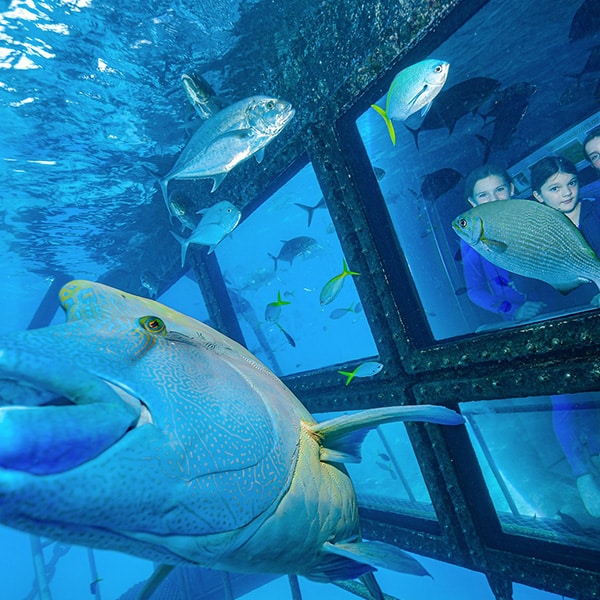
Underwater-Observatory
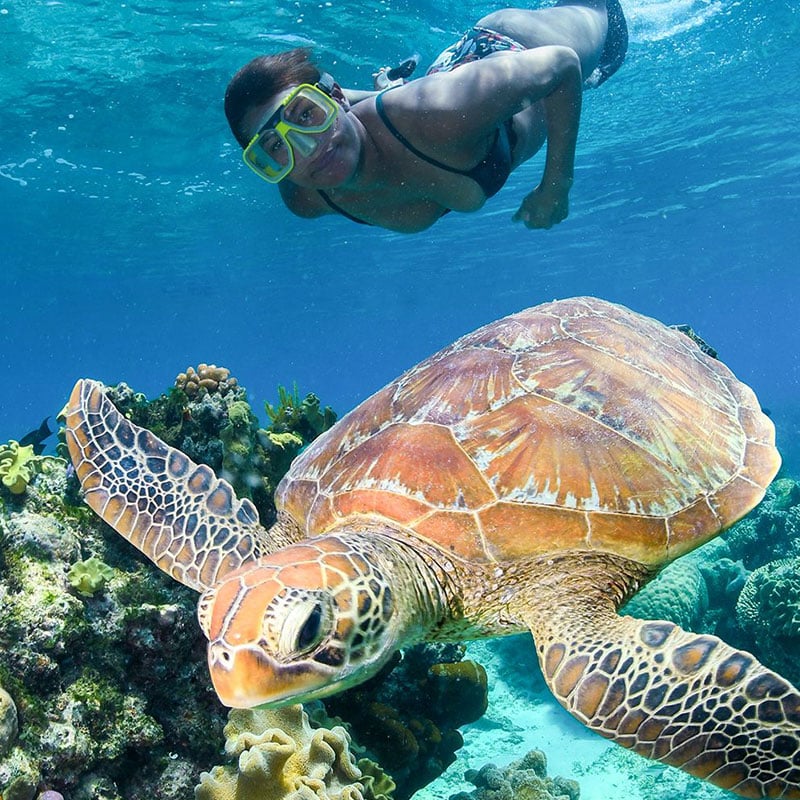
Snorkeling with Turtles on the Great Barrier Reef
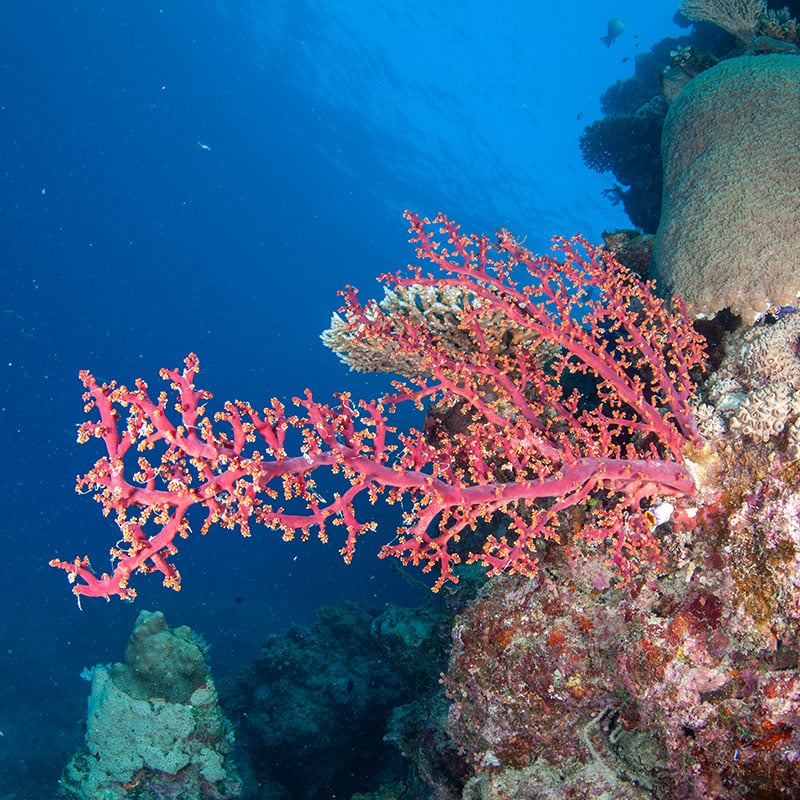
Red Seafans
History of the Great Barrier Reef
The Great Barrier Reef has a long and rich history dating back thousands of years. It is believed that the reef was formed around 20,000 years ago, when sea levels rose and flooded the continental shelf. Coral polyps, which are small animals that build reefs, began to grow on the submerged land, forming the coral reefs we know today.
The Great Barrier Reef was first discovered by Europeans in the late 18th century, when British navigator Lieutenant James Cook sailed along the coast of Australia. He named the reef after the barrier it presented to his ship, the HMS Endeavour.
Over the years, the Great Barrier Reef has played a significant role in the lives of the Indigenous Australians who have lived in the region for thousands of years. The reef has provided them with food, shelter, and a source of income through the sale of pearls.
Geology of the Great Barrier Reef
The Great Barrier Reef is made up of over 2,900 individual reefs and 900 islands, and it stretches for over 2,600 kilometers (1,600 miles) along the coast of Queensland, Australia. It is the largest coral reef system in the world and is visible from space.
The reefs are made up of coral polyps, which are small, soft-bodied animals that secrete a hard, calcium carbonate exoskeleton. These exoskeletons form the structure of the reef, and over time, they create a complex network of coral reefs that provides a habitat for a wide variety of marine life.
There are two main types of coral reefs found on the Great Barrier Reef: fringing reefs and barrier reefs. Fringing reefs are the most common type and are found close to the shore, often separated from the land by only a shallow lagoon. Barrier reefs, on the other hand, are found further offshore and are separated from the land by a deep channel or lagoon. The Great Barrier Reef is made up of both types of reefs.
Marine Life on the Great Barrier Reef
The Great Barrier Reef is home to an incredible diversity of marine life, including over 1,500 species of fish, over 400 species of coral, and numerous other species of animals and plants.
Some of the most well-known and popular marine species found on the Great Barrier Reef include:
- Clownfish: This little guy was made famous by the movie "Finding Nemo," clownfish are small, brightly-colored fish that are often found living in anemones.
- Stingrays: Stingrays come in all shapes and sizes, they are flat, diamond-shaped fish that are related to sharks. They can be found swimming near the bottom of the reef, and they are known for their long, whip-like tails that are armed with venomous spines.
- Turtles: Everybody wants to see a turtle! The Great Barrier Reef is home to six species of turtles, including the green turtle, hawksbill turtle, and loggerhead turtle. These creatures are known for their graceful swimming and are a popular sight on the reef.
- Shark: Most people are pretty nervous about seeing a shark. But did you know The Great Barrier Reef is home to over 135 species of sharks, including the grey reef shark, hammerhead shark, and tiger shark. While some species of sharks can be dangerous to humans, the vast majority of sharks on the reef pose no threat and are important to the ecology of the reef.
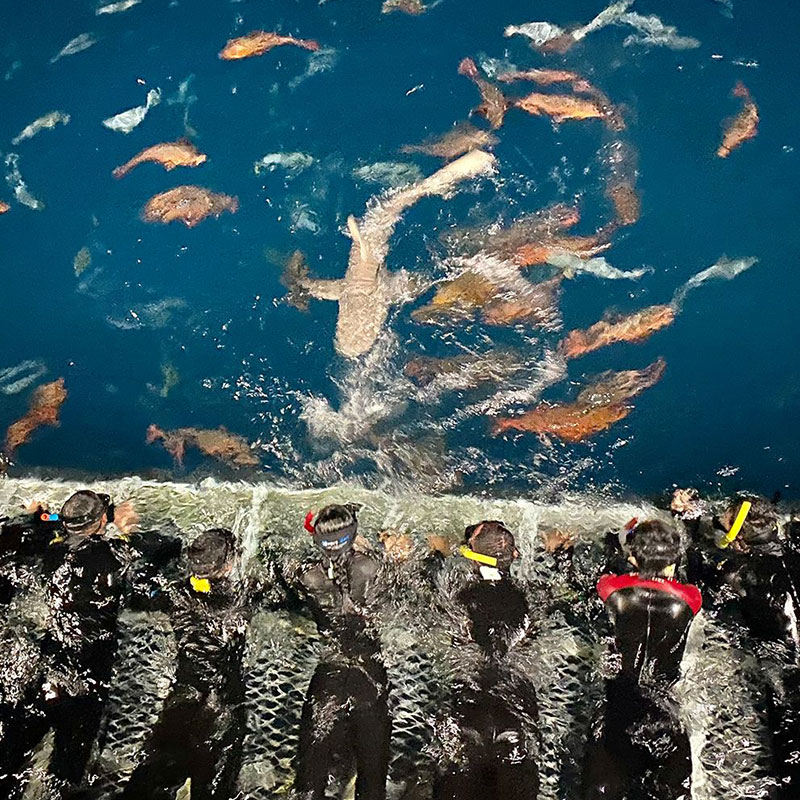
Shark Encounter on Ocean Quest Boat
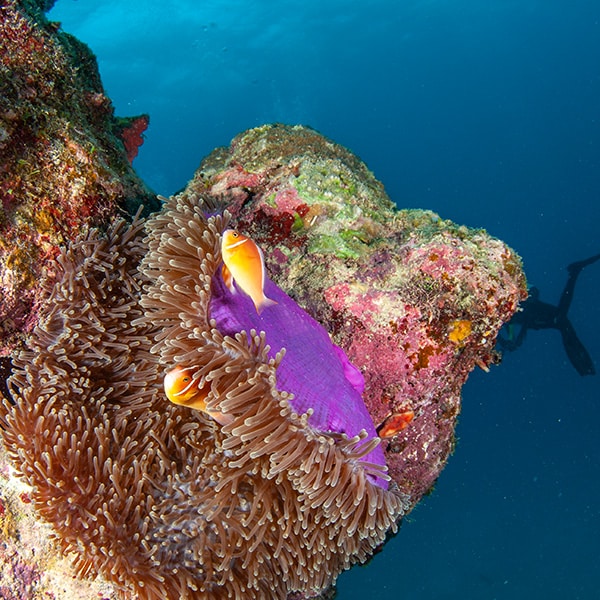
Beautiful Healthy Corals
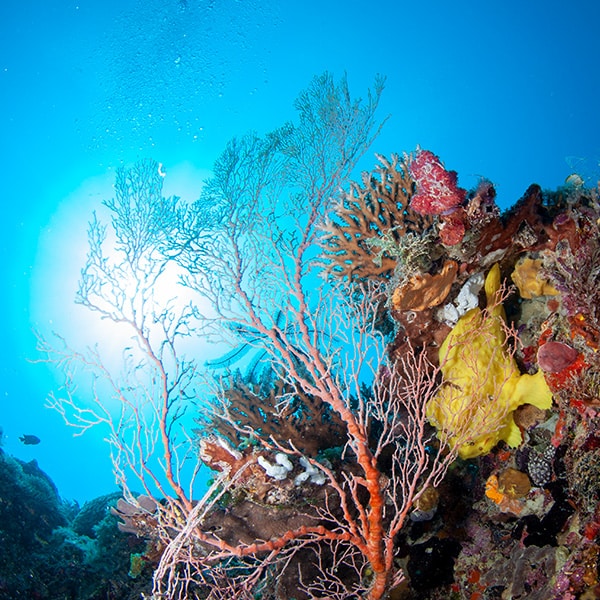
Yellow Frog Fish and Pink Seafan
How to Visit the Great Barrier Reef
Cairns is a popular destination for both snorkeling and scuba diving, located in the tropical north of Queensland, Australia. The city is the gateway to the Great Barrier Reef, the world's largest coral reef system, and offers a wide range of diving opportunities for all levels of divers. In this section, we will explore the best places to scuba dive and snorkel from Cairns and the top diving sites that should not be missed.
The Great Barrier Reef for Scuba Divers
The Great Barrier Reef is a must-see for scuba divers, it really is spectacular! Did you know it is only a short boat ride from Cairns? The reef system supports an extraordinary variety of marine life, including approximately 1,500 kinds of fish, 400 species of corals, and several other animals and plant species.
On the Great Barrier Reef, there are numerous diving sites to choose from, and trying to find the perfect one will depend on your degree of diving experience and what you are looking for i.e. shallow dives, deep dives, etc. The following are some of the most popular diving spots in the Great Barrier Reef:
- Agincourt Reef: This diving site is located on the outer edge of the Great Barrier Reef and offers a chance to see a wide variety of marine life, including sharks, rays, and turtles. The site is suitable for divers of all levels, with a variety of dive sites to choose from.
- Flynn Reef: One of our favorites, Flynn Reef is located just a short boat ride from Cairns and offers a variety of diving sites for all levels of divers. The reef is known for its colorful coral and diverse marine life, including schools of tropical fish and occasional sightings of sharks and rays.
- The Cod Hole: Located on the Ribbon Reefs north of Port Douglas, the Cod Hole is a popular diving site known for its friendly giant potato cod fish, which are known to interact with divers. The site is suitable for experienced divers and offers a chance to see a wide variety of marine life, including sharks, rays, cuttlefish, and turtles.
Want to learn more about the dive sites from Cairns? Check out our interactive Cairns Dive Sites Map this will give you a lot more information about the amazing dive sites found in both Cairns and Port Douglas.
The SS Yongala Wreck
The SS Yongala wreck is a popular diving site located off the coast of Townsville, which is a short flight from Cairns. The wreck is the remains of a passenger ship that sank in 1911, and it is now home to a wide variety of marine life, including schools of tropical fish, sharks, rays, and turtles.
The SS Yongala wreck is suitable for experienced divers and offers a unique diving experience, with the opportunity to explore the remains of the ship and see the diverse marine life that has made it home.
The Temple of Doom
The Temple of Doom is a diving site located in the Coral Sea, which is a short boat ride from Cairns. The site gets its name from the large, temple-like structures that rise from the seabed, covered in colorful coral and home to a variety of marine life.
The Temple of Doom is suitable for experienced divers and offers a chance to see a wide variety of marine life, including schools of tropical fish, sharks, rays, and turtles.
Tips for Scuba Diving in Cairns
- Choose a reputable diving operator: There are many diving operators to choose from in Cairns, and it is important to choose a reputable one that has a good safety record. Look for operators that are accredited by industry bodies such as PADI and SSI.
- Get in shape: Scuba diving can be physically demanding, and it is important to be in good physical shape before you go diving. Make sure to get a medical check-up before you go diving and consider getting in shape with some cardiovascular exercise beforehand.
- Learn to dive: If you are not already a certified diver, consider taking a diving course before you go diving in. Or complete a dive course while out on the reef!
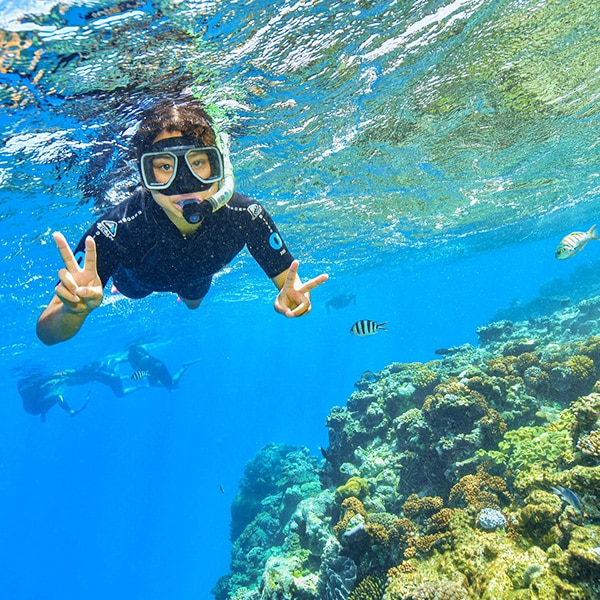
Snorkeling at Moore Reef Cairns Australia
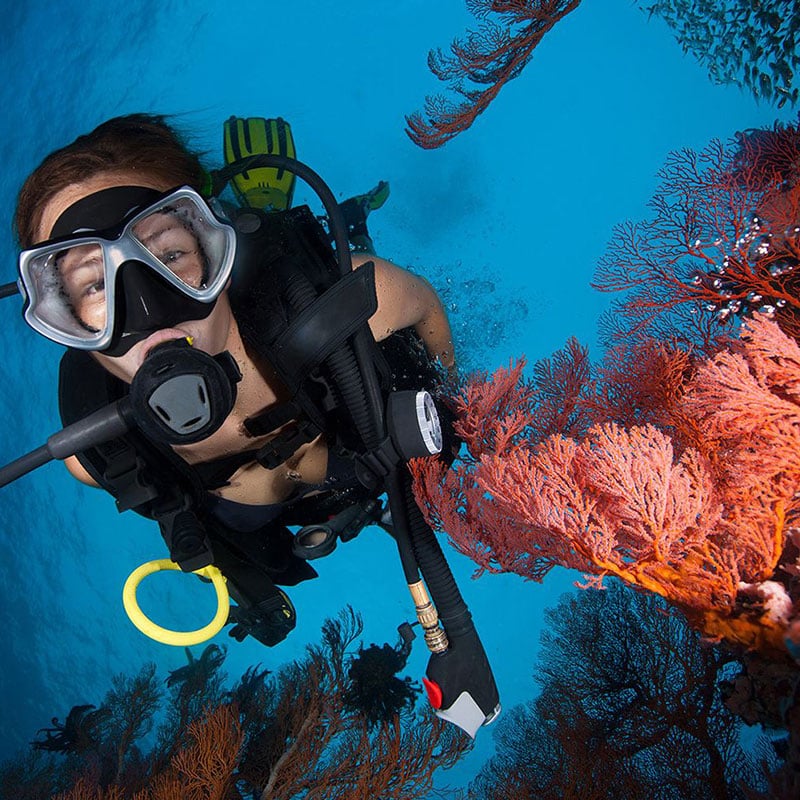
Advanced Dive Course with PADI
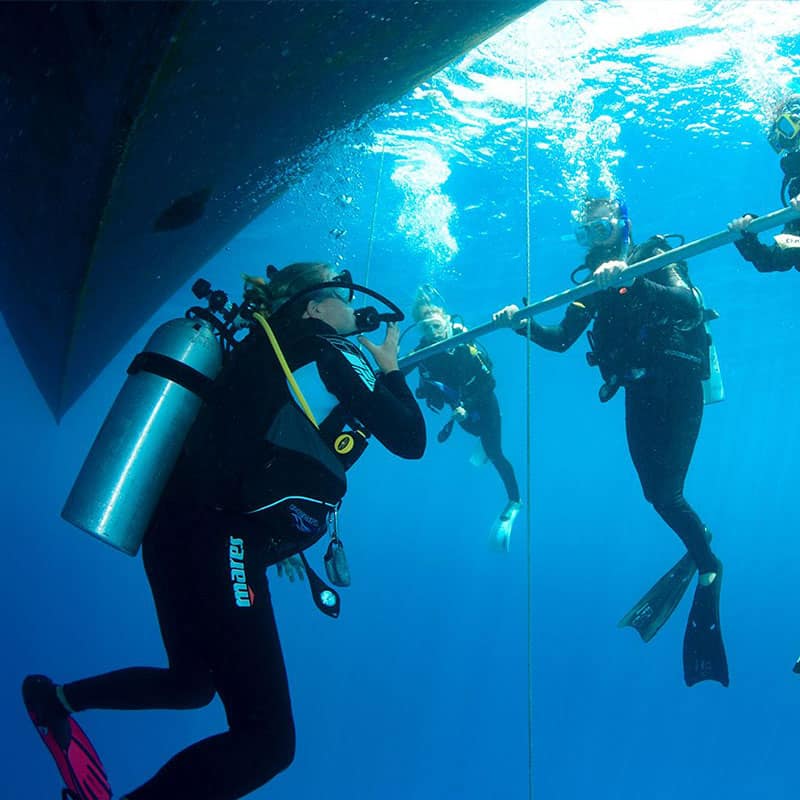
Introductory Diving on Aqua Quest
Scuba diving in Cairns, Australia offers some of the most breathtaking underwater experiences in the world. Located in the Great Barrier Reef, and starring in documentaries such as the Great Barrier Reef by David Attenborough. Cairns is home to a vast array of marine life, including colorful fish, sharks, turtles, and more. If you're planning a scuba diving trip to Cairns, here are some tips to help you make the most of your experience:
- Get certified: Before you can go scuba diving in Cairns, you'll need to get certified. This usually involves completing a series of theory and practical lessons, followed by a series of open-water dives. There are several diving schools in Cairns that offer certification courses, so it's a good idea to shop around and find one that suits your needs. Get in touch with our dive crazy reservation team and we can help you choose the perfect dive course.
- Choose the right dive operator: There are many dive operators in Cairns, and it's important to choose one that is reputable and experienced. Look for operators that have a good safety record and use modern equipment. It's also a good idea to ask about the experience level of the dive instructors, as you'll want someone who is knowledgeable and able to provide a safe and enjoyable diving experience.
- Know your limits: Scuba diving can be a physically demanding activity, and it's important to know your limits. If you're not a strong swimmer, or if you have any medical conditions that may affect your ability to dive, it's important to let your dive instructor know. They can help you decide if scuba diving is right for you, and can also provide recommendations for alternative activities if necessary.
- Bring the right gear: Scuba diving requires specialized gear, and it's important to make sure you have everything you need before you hit the water. This includes a wetsuit, fins, a mask, and a regulator. It's also a good idea to bring a dive computer, which will help you track your dive time and depth, as well as a dive light, which can be useful for exploring darker areas of the reef. If you don't have any gear don't worry! All dive boats offer gear as part of their service.
- Learn about the marine life: The Great Barrier Reef is home to a vast array of marine life, and it's a good idea to learn about the different species you may encounter before you dive. This will help you identify the different fish and other animals you see, and will also give you a greater appreciation for the underwater world.
- Respect the environment: The Great Barrier Reef is a fragile ecosystem, and it's important to respect the environment when you're scuba diving. This means avoiding touching or disturbing the coral and marine life, and following all dive rules and regulations.
- Take breaks: Scuba diving can be physically demanding, and it's important to take breaks and surface when you need to. This will help you avoid fatigue and maintain your safety while diving.
- Stay hydrated: Don't drink alcohol while on a dive trip! It's important to stay hydrated while scuba diving, as the dry air inside your wetsuit can lead to dehydration. Make sure to drink plenty of water before, during, and after your dive to keep your body properly hydrated.
- Get travel insurance: Scuba diving can be a risky activity, and it's a good idea to get travel insurance to protect yourself in case of any accidents or injuries. Look for a policy that covers scuba diving and other adventure activities, and make sure to read the fine print so you know exactly what is and isn't covered. Google Search "DAN Dive Travel Insurance" this is always a good option.
- Have fun: Above all, scuba diving in Cairns should be an enjoyable and memorable experience. So relax, have fun, soak up the magical underwater world of the Great Barrier Reef and make the most of your time underwater.
Overall, scuba diving in Cairns is often referred to as some of the very best scuba diving in the World.
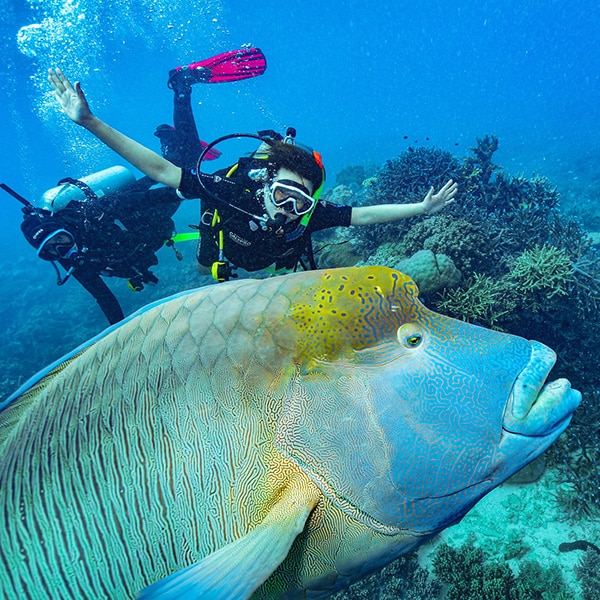
Wally the Mauri Wrasse at Moore Reef
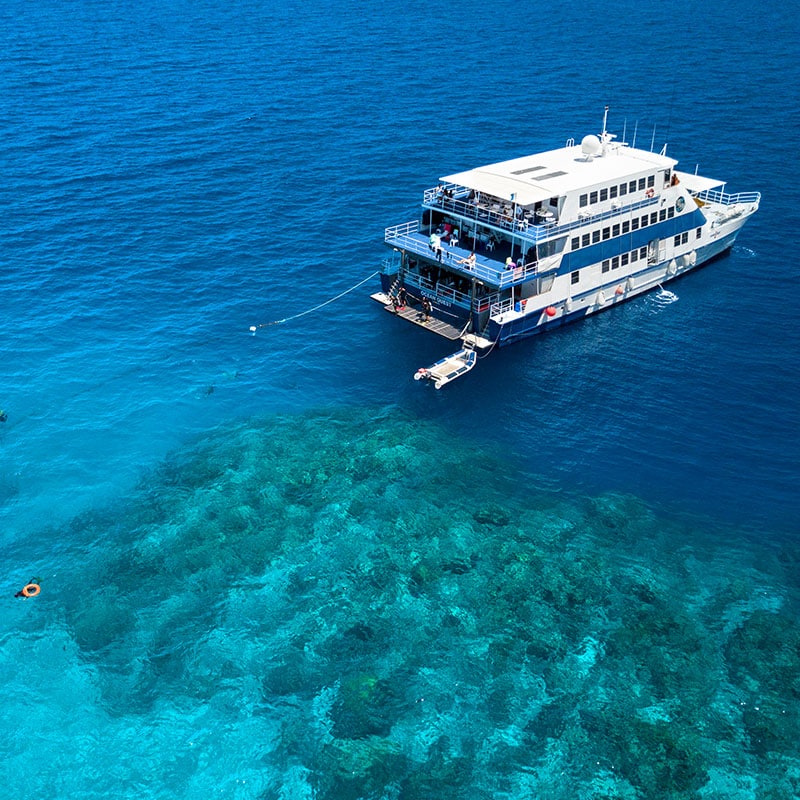
Ocean Quest at Norman Reef Cairns
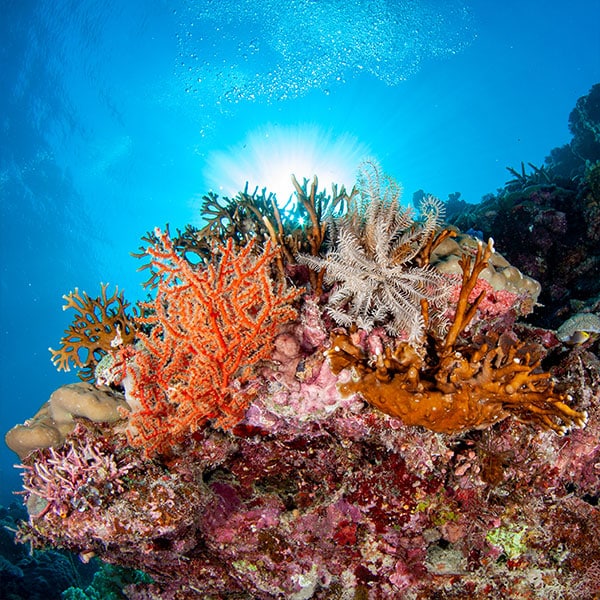
Soft and Hard Corals
How to Enjoy the Great Barrier Reef
In this section, we will talk about all the different ways you can enjoy The Great Barrier Reef. We already know it is located off the coast of Cairns, Australia, and that it is the world's largest coral reef system and home to an incredible array of marine life. So it is no surprise that this natural wonder is a top destination for tourists from around the globe. If you're planning a trip to Cairns and want to experience the beauty of the Great Barrier Reef, here are some tips to help you make the most of your visit.
- Choose the right tour operator: What we mean by this is there are many tour operators in Cairns that offer Great Barrier Reef tours, and it's important to choose one that is reputable and experienced. Look for operators that have a good safety record and use modern, well-maintained equipment, and modern boats, with highly experienced staff. It's also a good idea to ask about the experience level of the tour guides, as you'll want someone who is knowledgeable and able to provide a safe and enjoyable experience.
- Decide on the type of tour: There are many different types of Great Barrier Reef tours available, so it's important to choose one that suits your interests and needs. If you're an experienced scuba diver, you may want to choose a diving tour that takes you to some of the more remote areas of the reef. If you're not a diver, you can still experience the beauty of the reef by choosing a snorkeling tour or a glass-bottom boat tour if you are a non-swimmer.
- Know your limits: The Great Barrier Reef can be a physically demanding destination, and it's important to know your limits. If you're not a strong swimmer, or if you have any medical conditions that may affect your ability to participate in water activities, it's important to let your tour operator know. They can help you decide if a particular tour is right for you, and can also provide recommendations for alternative activities if necessary. For example, liveaboard dive trips to the Coral Sea require all divers have their advanced dive certification before getting onto the boat!
- Bring the right gear: Now depending on the type of tour you choose, you may need to bring certain gear with you. If you're going on a diving or snorkeling tour, you'll need a wetsuit, fins, a mask, and a snorkel. If you're going on a glass-bottom boat tour, you'll likely just need sunscreen, a hat, and a camera. It's a good idea to check with your tour operator to find out exactly what you'll need.
- Learn about the marine life: This might seem like an obvious one, but The Great Barrier Reef is home to a vast array of marine life, and it's a good idea to learn about the different species you may encounter before you go. This will help you identify the different fish and other animals you see, and will also give you a greater appreciation for the underwater world. Remember some corals can burn you like fire coral, and some species of shell have large spikes that want to spike you!
- Respect the environment: The Great Barrier Reef is a fragile ecosystem, and it's important to respect the environment when you're visiting. This means avoiding touching or disturbing the coral and marine life, and following all tour rules and regulations. There is strictly no standing on the coral at any time this is a real no-no.
- Stay hydrated: It's important to stay hydrated while participating in water activities, as the dry air and physical exertion can lead to dehydration. Make sure to drink plenty of water before, during, and after your tour to keep your body properly hydrated. All tour companies provide freshwater bubblers on their boats.
- Get travel insurance: Great Barrier Reef tours can be a risky activity if you are unfit and not in good shape or have a preconceived medical condition, and it's a good idea to get travel insurance to protect yourself in case of any accidents or injuries. Look for a policy that covers water activities and other adventure sports, and make sure to read the fine print so you know exactly what is and isn't covered.
- Plan for the weather: The weather in Cairns can be unpredictable, with high humidity and the potential for strong winds and storms. Generally, the wet season is from December thru to March/April each year. The dry season can be April thru October/November each year. See our detailed month-by-month guide for Cairns Dive Seasons.

Underwater-Observatory
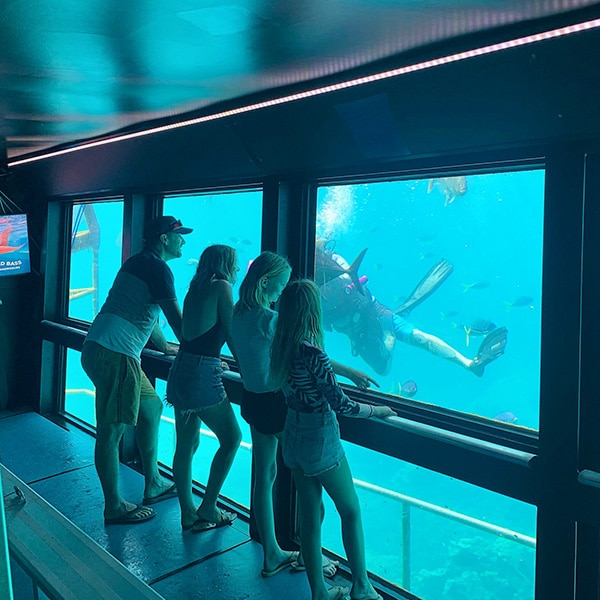
Underwater-Observatory
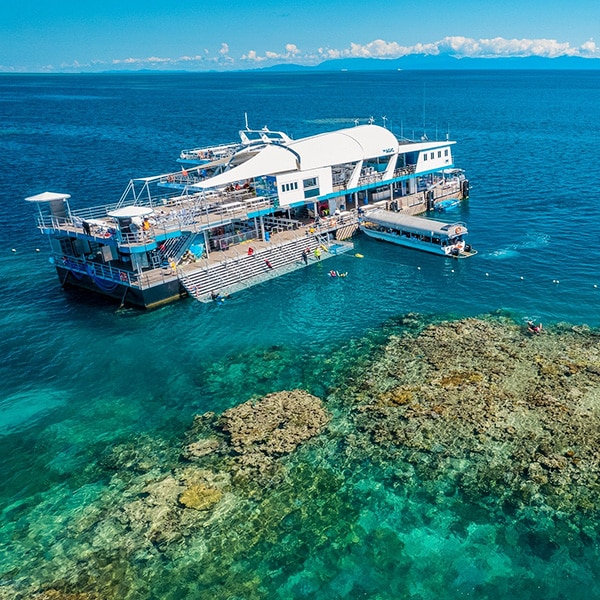
Beautiful New Pontoon from Reef Magic Cruises
Best way to visit the Great Barrier Reef if you cannot swim
We have a detailed guide on how to visit The Great Barrier Reef if you cannot swim. But as you know many people visit the reef to go scuba diving or snorkeling, but there are plenty of other ways to experience the beauty of this underwater paradise. If you're unable to swim, or if you simply prefer to stay on the surface, here are some of the best ways to visit the Great Barrier Reef.
- Glass-bottom boat tours: A glass-bottom boat tour really is a great way to see the reef without getting wet. These tours typically involve a boat with a large window in the bottom, allowing you to see the marine life and coral below without having to dive in. Many of these tours also include stops at different parts of the reef, where you can learn about the different marine species. They are also good for taking photos from the surface.
- Semi-submersible tour: These are even better than glass-bottom boats. A semi-submersible tour is another option for those who want to see the reef but aren't comfortable diving or snorkeling. These tours involve a boat with a partially submerged viewing area, allowing you to get a closer look at marine life and coral without having to get in the water. Some semi-submersible tours also include a guided tour and the opportunity to learn about the reef from a marine biologist.
- Scenic reef flight: If you want to see the reef from a different perspective, a scenic flight might be the way to go. There are several companies in Cairns that offer flights over the Great Barrier Reef, from either a helicopter or fixed-wing airplane. These provide breathtaking views of the coral and marine life below. These flights are a great option for those who are unable to participate in water-based activities, or for those who just want to see the reef from a different angle. You can often see stingrays and sea turtles on scenic flights!
- Island day trip: Enjoy a beautiful day at the beach! If you want to experience the reef but don't want to spend the entire day on the water, a day trip to one of the islands in the Great Barrier Reef is a good option. Many of these trips include a guided tour of the island and the opportunity to learn about the local marine life and ecosystems. Some trips also include snorkeling or diving, but you can usually opt out of these activities if you prefer.
- Aquarium or marine park: If you're unable to visit the Great Barrier Reef in person, another option is to visit a local aquarium or marine park. You could visit the Cairns Aquarium, which is open 7 days per week and is modeled on the Great Barrier Reef. Many of these facilities have tanks or exhibits that mimic the conditions of the reef, allowing you to see a variety of marine life up close. While not the same as experiencing the reef in person, these facilities can still provide a glimpse into the underwater world. They are a great learning experience for children and families.
Overall, there are plenty of ways to visit the Great Barrier Reef, even if you're unable to swim or participate in water-based activities. By choosing the right tour or activity, you can still experience the beauty of this natural wonder without putting yourself in any danger. So, these are the best ways to visit the Great Barrier Reef if you cannot swim.
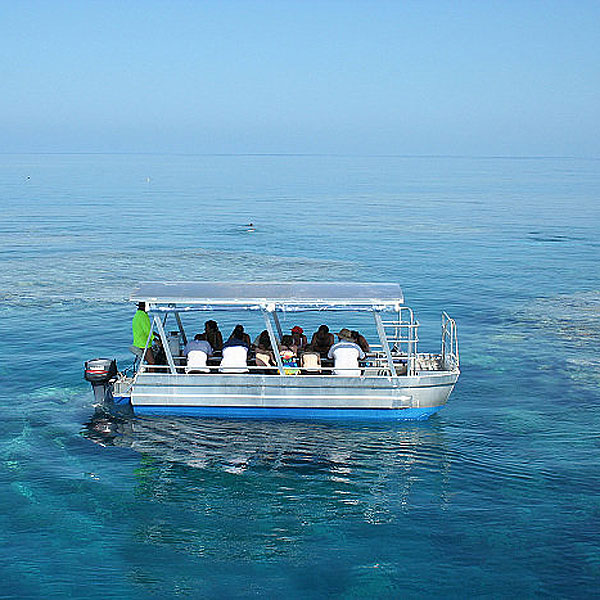
Glass Bottom Boat
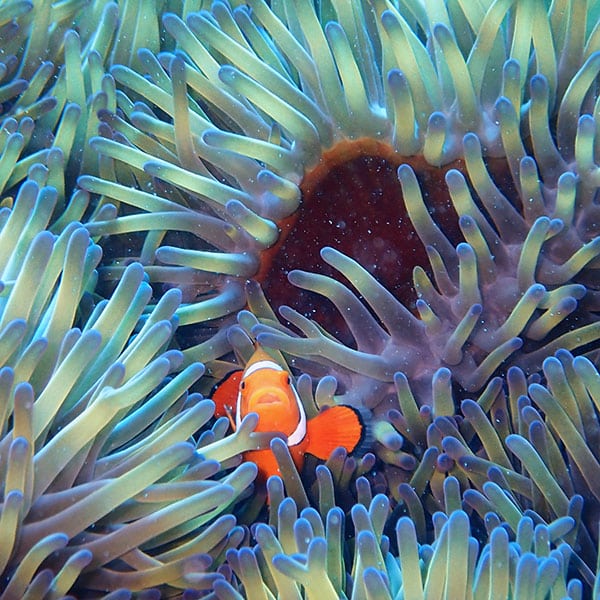
Orange-White Anemonefish found on the Great Barrier Reef
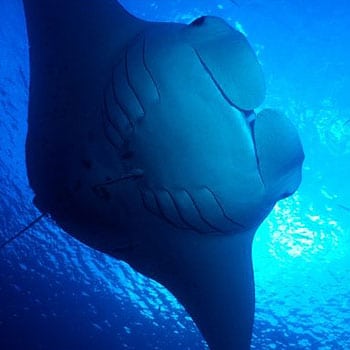
Manta Ray
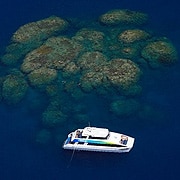
Tusa Dive
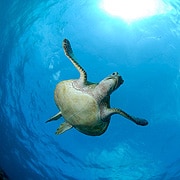
Turtles
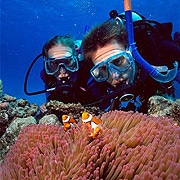
Try a Scuba Dive
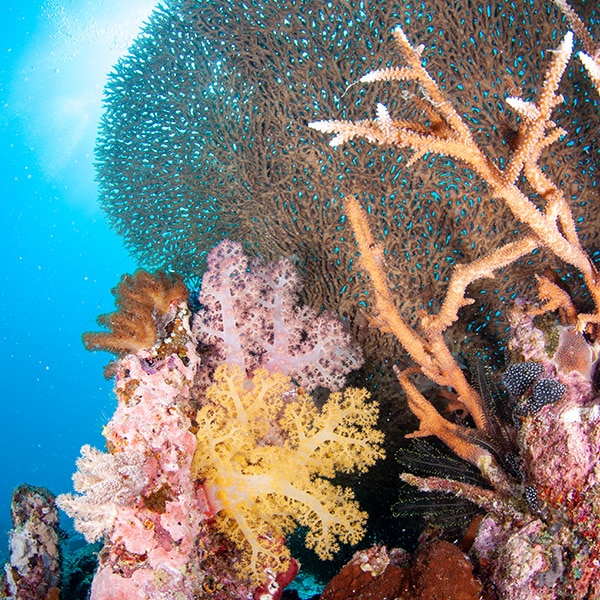
Beautiful Healthy Corals
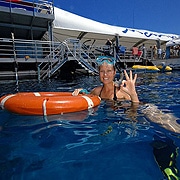
Pontoon Snorkeling

Semi-Submarine
Cairns Dive Adventures has been on every Cairns outer reef cruise and pontoon. We are happy to provide unbiased advice and trip reviews, to help you select the best day tour to suit your budget and experience. All of these trips are full day tours. Contact us for more info on +61 7 4041 1638 | reservations@cairnsdiveadventures.com
Sunlover Cruises
Silverswift Dive & Snorkel
Evolution Dive & Snorkel Cruise
Divers Den: Aqua Quest
Reef Magic Cruises
Great Adventures: Green Island & Great Barrier Reef
Passions Of Paradise
Reef Experience
Ocean Freedom Cruise
Great Adventures: Outer Reef Pontoon
Silversonic Dive & Snorkel
Ocean Spirit Cruises – Michaelmas Cay
Poseidon Snorkel and Dive
Quicksilver Outer Great Barrier Reef Cruises
Dreamtime Dive & Snorkel Cruises
Pure Snorkel – Half Day Reef Tour
Spirit of Cairns – Buffet Dinner Cruise
Moore Reef & Fitzroy Island Full Day Reef Tour
Search for Tours:
Cairns Reef Information
Click the links below to find out more.
Do you need help choosing a trip?
Can't decide? We have personally been on every Cairns reef and diving trip. We can help you choose the best tour, to suit your experience and budget.
Special
FREE UNDERWATER CAMERA HIRE*
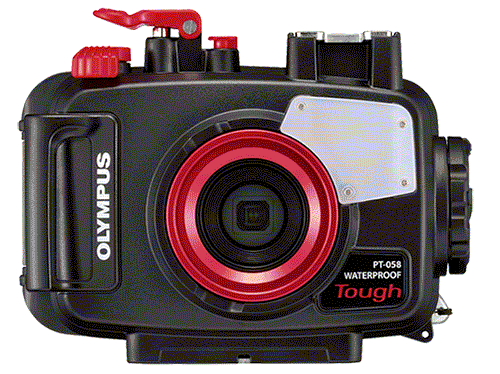
Spend over $550.00 AUD on your Great Barrier Reef tour with us and receive the latest Digital Underwater Camera Hire. Take amazing High-Resolution images and 1080 HD Video. Only when you book online thru our website.
Not available for any tours to the Islands as fine white sand damages the seals on the cameras and makes them leak!
You need to come into our shop located on the Cairns Esplanade the day before departure to pick up the camera before 5:30 pm. You also need to supply your own SD Camera Card and drop the camera off back at our shop before 5:30pm.
Please Remember there is no other way to collect our cameras! All passengers must come into our shop the day before departure day before 5:30 pm.


